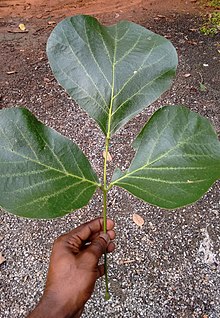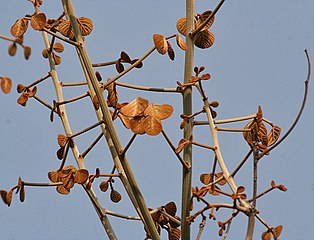Butea monosperma
This article needs additional citations for verification. (April 2015) |
| Butea monosperma | |
|---|---|

| |

| |
| Top: inflorescence, bottom: leaf | |
| Scientific classification | |
| Kingdom: | Plantae |
| Clade: | Tracheophytes |
| Clade: | Angiosperms |
| Clade: | Eudicots |
| Clade: | Rosids |
| Order: | Fabales |
| Family: | Fabaceae |
| Subfamily: | Faboideae |
| Genus: | Butea |
| Species: | B. monosperma
|
| Binomial name | |
| Butea monosperma | |
| Synonyms | |


Butea monosperma is a species of Butea native to tropical and sub-tropical parts of South Asia and Southeast Asia. It is also known as flame of the forest, dhak, palash, and bastard teak.[2] Revered as sacred by Hindus, it is prized for producing an abundance of vivid blooms, and it is also cultivated elsewhere as an ornamental.[4]
The plant grows across Bangladesh, India, Nepal, Pakistan, Sri Lanka, Myanmar, Thailand, Laos, Cambodia, Vietnam, Malaysia, and western Indonesia.[2]
Description[edit]
Butea monosperma is a small-sized dry-season deciduous tree, growing to 15 m (49 ft) tall. It is slow-growing: young trees have a growth rate of a few feet per year. The leaves are pinnate, with an 8–16 cm (3.1–6.3 in) petiole and three leaflets. Each leaflet is 10–20 cm (3.9–7.9 in) long. The flowers are 2.5 cm (0.98 in) long, bright orange-red, and produced in racemes up to 15 cm (5.9 in) long. The fruit is a pod 15–20 cm (5.9–7.9 in) long and 4–5 cm (1.6–2.0 in) broad.[5]
The flowers frequently have a spectacular late-winter bloom (February to April), although the trees do not flower every year.[6] Each flower features five petals, two wings, and a keel that resembles the curled beak of a parrot.[7] If the winter season is too cold, too dry, or too rainy, trees may not blossom.
History[edit]
This section needs expansion. You can help by adding to it. (November 2012) |
Historically, palash originated in Bihar and Jharkhand. Dhak forests covered much of the Doaba area between the Ganges and the Yamuna rivers, but these were cleared for agriculture in the early 19th century as the English East India Company increased tax demands on the peasants.[8]
Use[edit]
The plant is used to make timber, resin, fodder, medicine, and dye. The wood is dirty white and soft. Being durable under water, it is used for well curbs and water scoops. Spoons and ladles made of its wood are used in various Hindu rituals to pour ghee into the fire. Good charcoal can be obtained from it. Farmers typically plant trees on field bunds and use them to reduce soil erosion. Young shoots are grazed by buffaloes as fodder. The leaves were once used to serve food where plastic plates would be used today.

Lac production[edit]
In India, the tree serves as a crucial host for the lac bug (Laccifer lacca), which creates shellac. It produces the most lac sticks per hectare of any lac tree.[9]
Leather production[edit]
The bark produces a crimson exudate that, when dried, hardens into a substance called "Butea gum" or "Bengal kino". The gum is considered valuable by druggists because of its astringent qualities and by leather workers because of its tannin.[10]
Culinary use[edit]
The gum from the tree, called kamarkas in Hindi, is used in certain food dishes.
In Maharashtra state of India it is prepared as a summer beverage out of tea of the flower which is considered to have medicinal benefits [11]
Patravali plate[edit]
In villages of many parts of India, for example in Maharashtra, this tree provides the leaves that are used either with many pieced together or singly (only in case of a banana leaf) to make a leaf-plate for serving a meal. Up until a century ago, a would-be-son-in-law was tested on his dexterity in making this plate and bowl (used to serve daal, gravy dishes) before being declared acceptable by the father-in-law-to-be.[12]
Dye[edit]
The flowers are used to prepare a traditional Holi colour called "Kesari". It is also used as a dye for fabric. Butein, a vibrant yellow to deep orange-red dye made from the flowers, is used mostly for dying silk and occasionally for dying cotton. Hindus ink their foreheads with this colour.
Literature[edit]
The first sloka of the Sukla Yajurveda speaks about the Palasa tree. The Palasa tree branch is cut and trimmed by the Adhvaryu priest who performed the practical part of sacrifice, the day before a new moon or a full moon, and used it to drive the calves away from cows whose milk was to form a part of the offerings for the next day's special ceremony.[13]
A History of the Sikhs Vol. 1, written by Punjabi writer Khushwant Singh, includes the flame of the forest in his description of the landscape of Punjab. He writes, "While the margosa is still strewing the earth with its brittle ochre leaves, the silk cotton, the coral and the flame of the forest burst into flowers of bright crimson, red, and orange."[14] References to this tree are often found in Punjabi literature. The Punjabi poet Harinder Singh Mehboob employed its symbolism in his poems.
In Rudyard Kipling's short story Beyond the Pale (contained in Plain Tales from the Hills, published in 1888), he says of the dhak: The flower of the dhak means diversely "desire", "come", "write", or "danger", according to the other things with it. The tree was also featured in The Jungle Book in the story Tiger! Tiger! as the tree Mowgli instructs his wolf-brother Grey Brother to wait under for a signal that Shere Khan has returned.
Cultural associations[edit]
According to legend, the tree sprang from a falcon's feather that was infused with soma. The right side of Yama's body is where the plant, according to Vayupurana, had its start. This lovely tree is revered by both Hindus and Buddhists. It is said to have used as the tree for achieved enlightenment, or Bodhi by second Lord Buddha Medhaṅkara Buddha.[15]
In West Bengal, it is associated with spring, especially through the poems and songs of Nobel Laureate Rabindranath Tagore, who likened its bright orange flame-like flower to fire. In Santiniketan, where Tagore and Vishalnarayan lived, this flower has become an indispensable part of the celebration of spring. The plant has lent its name to the town of Palashi, famous for the historic Battle of Plassey fought there.[16]
In the state of Jharkhand, palash is associated with folk tradition. Many folk literary expressions describe palash as the forest fire. The beauty of dry deciduous forests of Jharkhand reach their height when most trees have shed their leaves and the Palash is in its full bloom. Palash is also the State Flower of Jharkhand.
It is said that the tree is a form of Agni, the God of fire and war.[citation needed] In Telangana, these flowers are specially used in the worship of Shiva on occasion of Shivaratri. In Telugu, this tree is called Moduga chettu.
In Kerala, it is called plasu, chamata or vishalnarayan. Chamata is the vernacular version of Sanskrit word harinee, small piece of wood that is used for agnihotra or the fire ritual. In most of the old Nambudiri (Kerala Brahmin) houses, one can find this tree because this is widely used for their fire ritual. Tamil Brahmins have a daily agnihotra ritual called Samidha Dhanan, where barks of this tree is a main component for agnihotra, and this ritual is very essential for brahmacharis during the first year of brahmacharya.
In other languages[edit]

- Paaraas/ Tens (পারাস /টেঁস) (Kudmali / Kurmali)
- tamāla (तमाल)
- palasha (पलाश) (Sanskrit)
- ḍhāk (ढाक) (Nepali)
- chheula (छेउला) (Hindi)
- paḷas (पळस) (Marathi)
- kesudo (કેસુુડો) (Gujarati)
- palashpapra (Urdu)
- muthuga (ಮುತ್ತುಗ) (Kannada)
- kinshuk
- polash (পলাশ) Bengali
- pauk (Burmese)
- polāx (পলাশ) in Assamese
- chichra tesu
- desuka jhad
- chalcha
- kankrei
- porasum, parasu (Tamil )
- muriku
- shamata (Mal.)
- moduga (మోదుగ) (Telugu)
- khakda (Guj.)
- kela (Sinhala)
- ploso (Javanese)
- palash ପଳାଶ (Odia)
- semarkat api (Malay)
- palay (Pushto)
Gita Govinda[edit]
In Sanskrit, the flower is extensively used as a symbol for the arrival of spring and the colour of love. Jayadeva in the Gita Govinda compares these blossoms to the red nails of Kamadeva or Cupid, with which the latter wounds the hearts of lovers. The imagery is all the more appropriate as the blossoms are compared to a net of kimsuka flowers (किंशुकजाले). In a completely leafless tree, the blossoms look like a net.
The following stanza is translated by Barbara Stoller Miller; for kimsuka blossoms, she uses the common name "flame tree petals":
- मृगमदसौरभरभसवशंवदनवदलमालतमाले।
- युवजनहृदयविदारणमनसिजनखरुचिकिंशुकजाले॥
- Tamala tree's fresh leaves absorb strong scent of deer musk.
- Flame tree petals, shining nails of love, tear at young hearts.
- Gita Govinda of Jayadeva, Love Song of the Dark Lord, Motilal Banarsidass
Gallery[edit]
-
habit of a sapling
-
in full bloom, late January
-
dark flower buds in February
-
green seed pods, early April
-
flushes of new leaves, mid-April
References[edit]
- ^ "Butea frondosa Roxb. Ex Willd. | Plants of the World Online | Kew Science".
- ^ a b c "Butea monosperma". Germplasm Resources Information Network. Agricultural Research Service, United States Department of Agriculture. Retrieved 2009-10-24.
- ^ "Butea monosperma (Lam.) Taub". theplantlist.org. ThePlantList. Retrieved 28 June 2020.
- ^ Shah, Vaishali (2019-01-18). "Palasa | Hindu Lifestyle". Hindu Scriptures | Vedic lifestyle, Scriptures, Vedas, Upanishads, Itihaas, Smrutis, Sanskrit. Retrieved 2022-12-09.
- ^ Huxley, A., ed. (1992). New RHS Dictionary of Gardening. Macmillan ISBN 0-333-47494-5.
- ^ Tandon, Rajesh; Shivanna, K. R.; Mohan Ram, H. Y. (November 2003). "Reproductive Biology of Butea monosperma (Fabaceae)". Annals of Botany. 92 (5): 715–723. doi:10.1093/aob/mcg193. ISSN 0305-7364. PMC 4244857. PMID 14500327.
- ^ Desk, N. T. (2020-02-18). "The beauty of butea | The Navhind Times". Retrieved 2024-03-04.
- ^ Mann, Michael, Ecological Change in North India: Deforestation and Agrarian Distress in the Ganga-Yamuna Doab 1800–1850, in "Nature and the Orient" edited by Grove, Damodaran and Sangwan
- ^ "World Agroforestry | Transforming Lives and Landscapes with Trees". World Agroforestry. Retrieved 2022-12-09.
- ^ Cowen, D. V. (1984). Flowering Trees and Shrubs in India, Sixth Edition. Bombay: THACKER and Co. Ltd. p. 3.
- ^ "Flame that cools". 30 June 2012.
- ^ Phalak, Paresh Prashant. "Gifting Trees...: Flame of the Forest". Gifting Trees... Retrieved 2020-05-05.
- ^ Shri Venkateshwar Mudran Yantralay. Vajasaneyi Shri Shukla Yajurveda Samhita By Khemraj Shri Krishna Das Shri Venkateshwar Mudran Yantralay.
- ^ Singh, Khushwant. A History Of The Sikhs. Vol. I: 1469-1839. Oxford India. p. 6.
- ^ "Sacred Trees of BHU". sacredtreesbhu.com. Retrieved 2019-06-10.
- ^ "Battle of Plassey". britannica.com. Retrieved 2023-01-04.





